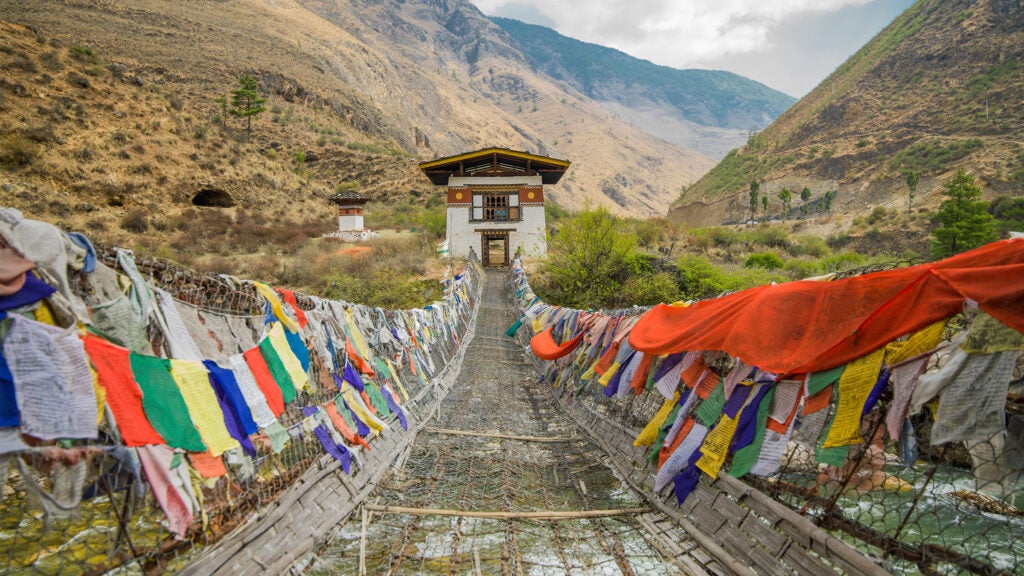Products You May Like
Get full access to Outside Learn, our online education hub featuring in-depth fitness, nutrition, and adventure courses and more than 2,000 instructional videos when you sign up for Outside+
Sign up for Outside+ today.
The historic 250-mile Trans Bhutan Trail (TBT) reopened this fall after decades of disuse following the construction of more convenient and direct highways in the 1960’s. Timed to coincide with the reopening of the country to international travelers after Covid, ambitious thru-hikers are now welcome to trek its length along the southern end of the Eastern Himalaya where the trail winds through villages, fortresses, past temples and rice paddies, over suspension bridges and through forests, into the wilderness and alongside capital cities as it stretches nearly from one border in the west to another in the east. The TBT is a true cross-country trek, and one that celebrates the kingdom’s past, present, and future.
The Trans Bhutan Trail dates at least as far back as the 16th century according to Rabsel Dorji, the trail’s head of marketing. And over that time, it has served many purposes: In the trail’s early days, it functioned as a religious pilgrimage route used to spread Buddhism, and soldiers and armies marched along the trail. Garps—legendary couriers you might call some of the world’s earliest thru-hikers—ran its length to share secret messages and deliver mail. The economy depended on the route to provide access to trade. And monarchs walked it—and continue to walk it—to meet with their people and unite the nation.
But over the past six decades, the construction of highways across the country sent the trail into neglect. And while sections of it remained in use for local work and recreation, time and nature erased miles of the path. That changed in 2019, when the king of Bhutan, Jigme Khesar Namgyel Wangchuck, announced that the country would rehabilitate its most storied long path.
Making it happen would take three years of hard work. As of September 28 of this year, the TBT’s entire length is open for locals and international travelers to hike, bike, or run.
Hikers will experience a variety of landscapes throughout the TBT, from rugged mountain passes to rhododendron forests to expansive wilderness, but the trail also passes through dozens of villages, temples, and major cities. Depending on the section of trail, hikers can stay at campsites with permanent tents and showers or three-star hotels in the towns the trail passes through.
Not only does the TBT offer a physical connection between villages and communities after decades of disconnect; it exists because of a collaboration between a slew of organizations: government, non-profit, and community. The Bhutan Canada Foundation, an organization that supports various initiatives related to education, culture, and democracy, spearheaded the project. The Tourism Council of Bhutan, the Royal Government of Bhutan, local governments and communities along the trail, the National Land Commission, the Scouts Association of Bhutan, public agencies, and volunteers from the DeSuung organization all came together to restore the trail.
The Bhutanese people were more than a little involved, too. Many volunteered on restoration projects, but the government offered jobs to some 900 citizens, most of whom were unemployed tourism professionals or from local communities directly impacted by the pandemic.
According to Dorji, hikers who tackle the trail will get to experience not just Bhutan’s terrain, but its history and modern-day culture as well. Local ambassadors share their stories of the trail in villages, shops, and hotels and along the way. QR codes line the trail, putting history and stories at hikers’ fingertips.
“The Trans Bhutan Trail represents a connection between Bhutan’s past, present, and future,” said Dorji. “It is the story of our forefathers, and how they walked on this trail to discover, to trade, to survive, to unite. It is the story of how our nation came to be, and how it continues to pave our way.”
No permits are required to hike the trail, but international visitors are required to hire a guide—not just on the trail, but throughout all of Bhutan for the duration of their stay. The Trans Bhutan Trail, the entity responsible for the restoration and sustainability of its namesake trail, offers tour packages, but independent trekking is not allowed. You’ll also need to obtain a visa before your trip and you should expect to pay a $200 per-person, per-day Sustainable Development Fee (which is included in some of the guided treks).
Spring and fall are the best times to visit, but any time of year hikers will need to plan travel carefully as only two airlines, Druk Air and Bhutan Airlines, are permitted to fly into Bhutan. What’s more, those airlines only serve a handful of airports in the region, including in India, Nepal, Singapore, and Thailand.
While a visit to the kingdom isn’t cheap or easy, the cost of booking a guided itinerary on the TBT does good: After guides are paid, 100 percent of profits from each trip go back into protecting and developing the trail.
There are day-long itineraries that tackle picturesque sections, weekend trips that offer a taste of the region, cycling and trail running adventures, and, of course, a guided 35-day, full-trail trek that covers the entire 250 miles. Whichever you pick, you’ll be supporting a rebounding tourism industry in one of the most beautiful places on earth.
“The last three years have been very difficult for the tourism industry in Bhutan. However, it has given us the opportunity to also pause and rethink how we can be more resilient and better positioned for the future,” Dorji said. “For us Bhutanese, the last three years has proven what we have always known: The journey on the Trans Bhutan Trail is not just about walking on an ancient physical route—it is an exploration of ancient traditions, an adventure through our ecological inheritance, and a celebration of a unique cultural heritage.”
